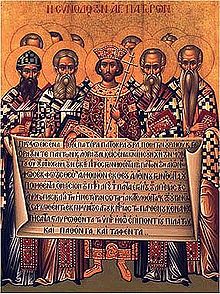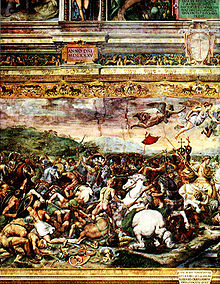- Constantinian shift
-
Constantinian shift is a term used by Anabaptist and Post-Christendom theologians to describe the political and theological aspects of the 4th-century process of Constantine's legalization of Christianity.[1] The term was popularized by the Mennonite theologian John H. Yoder.[2]
Contents
Historical context
 Icon depicting the Emperor Constantine (centre) and the bishops of the First Council of Nicaea (325) holding the Niceno–Constantinopolitan Creed of 381.
Icon depicting the Emperor Constantine (centre) and the bishops of the First Council of Nicaea (325) holding the Niceno–Constantinopolitan Creed of 381.
According to Eastern Orthodox and Roman Catholic tradition, Constantine I adopted Christianity as his system of belief after the Battle of Milvian Bridge in 312.[3][4][5] His legions, who were victorious, fought under the "labarum", a standard with the first two Greek letters of Christ's name.
In 313, the Edict of Milan legalised Christianity alongside other religions allowed in the Roman Empire. In 325, the First Council of Nicaea signalled consolidation of Christianity under an orthodoxy endorsed by Constantine, and though this did not make other Christian groups outside the adopted definition illegal, the dissenting Arian bishops were initially exiled. But Constantine reinstated Arius before his death and exiled Orthodox Athanasius of Alexandria. In 380 Emperor Theodosius I made Christianity the Roman Empire's official religion (see State church of the Roman Empire, Byzantine Empire and the Goths) and did enforce the edict. In 392 he passed legislation prohibiting all pagan cultic worship.[6]
During the 4th century, however, there was no real unity between church and state: In the course of the Arian controversy, leading Trinitarian bishops, such as Athanasius, Hilary of Poitiers, and Gregory of Nyssa, were exiled by Arian emperors, as were leading Arian and Anomoean theologians such as Aëtius.
Towards the end of the century, Bishop Ambrose of Milan made the powerful Emperor Theodosius do penance for several months after the massacre of Thessalonica before admitting him again to the Eucharist. On the other hand, only a few years later, Chrysostom, who as bishop of Constantinople criticized the excesses of the royal court, was eventually banished and died while traveling to his place of exile.
Theological implications
Critics point to this shift as the beginning of the phenomenon known as Caesaropapism. In its extreme form, such critics say, Christianity became a religious justification for the exercise of power and a tool in the expansion and maintenance of empire, a Christian empire, also known as Christendom.
Augustine of Hippo, who originally had rejected violence in religious matters, later justified it theologically against those he considered heretics, such as the Donatists, who themselves violently harassed their opponents.[7] Before him, Athanasius believed that violence was justified in weeding out heresies that could damn all future Christians.[8] This continued a line of thought started by Athanasius who felt that any means was justified in repressing the Arian belief.[9] In 385, Priscillian, a bishop in Spain, was the first Christian to be executed for heresy, though the most prominent church leaders rejected this verdict.
Theologians critical of the Constantinian shift also see it as the point at which membership in the Christian church became associated with citizenship rather than a personal decision. American theologian Stanley Hauerwas names the shift as the foundation for the expression of Christianity in the United States today that is closely associated with patriotism and civil religion.
See also
- Caesaropapism
- Christian anarchism
- Christian radicalism
- Constantinianism
- Constantinople
- Donatists
- Early Christianity and pacifism
- Erastianism
- Great Apostasy
- State church of the Roman Empire
- Sacralism
Notes
- ^ Clapp, Rodney (1996). A Peculiar People. InterVarsity Press. p. 23. "What might be called the Constantinian shift began around the year 200 and took more than two hundred years to grow and unfold to full bloom."
- ^ e.g. in Yoder, John H. (1996). "Is There Such a Thing as Being Ready for Another Millennium?". In Miroslav Volf, Carmen Krieg, Thomas Kucharz (ed.). The Future of Theology: Essays in Honor of Jurgen Moltmann. Eerdmanns. p. 65. "The most impressive transitory change underlying our common experience, one that some thought was a permanent lunge forward in salvation history, was the so-called Constantinian shift."
- ^ Lactantius XLIV,5
- ^ Eusebius XXVII-XXXII
- ^ Brown 2006, 60.
- ^ Theodosian Code, XVI.1.2
- ^ The Donatists and Their Relation to Church and State
- ^ Olson, 172
- ^ Barnes, 230.
Further reading
- Timothy Barnes, Constantine and Eusebius, 1981
- Theodosian Code, Henry Bettenson, ed., Documents of the Christian Church, (London: Oxford University Press, 1943), p. 31. see: http://www.fordham.edu/halsall/source/theodcodeXVI.html
- Peter Brown, The Rise of Western Christendom (Oxford: Blackwell Publishing, 2003),60.
- James Bulloch, From Pilate to Constantine, 1981
- Eusebius of Caesarea, Life of Constantine, Library of Nicene and Post Nicene Fathers, 2nd series (New York: Christian Literature Co., 1990), Vol I, 489-91. see: http://www.fordham.edu/halsall/source/conv-const.html
- Alistair Kee, Constantine Versus Christ, 1982
- Lactantius, Lucius Caecilius Firmianus, On the manner in which the persecutors died (English translation of De Mortibus Persecutorum) see: http://www.intratext.com/IXT/ENG0296/_P18.HTM
- Ramsay MacMullen, Christianising the Roman Empire, 1984
- Roger E. Olson, The Story of Christian Theology, 1999
External links
- Social Constantinianism - an Evangelical perspective on the Constantinian shift
- [1] - Basil's Struggle with Arianism after Constantine.
- Timeline of Fourth-Century Roman Imperial Laws showing the Constantinian shift
Categories:- Constantine the Great and Christianity
- Christianity-related controversies
- Ecclesiology
- Christian terms
- Christianity under the Roman Empire
Wikimedia Foundation. 2010.


